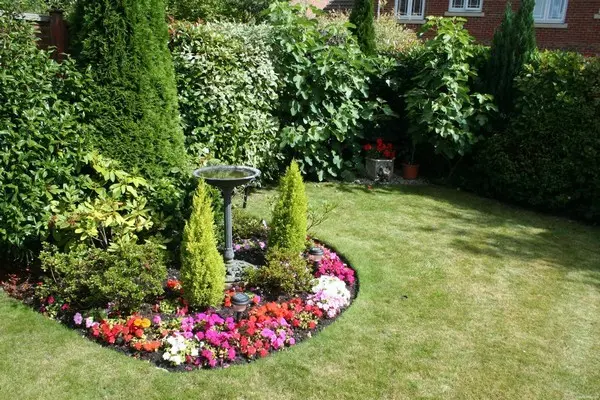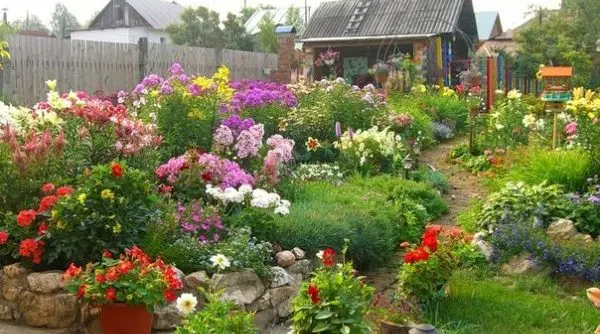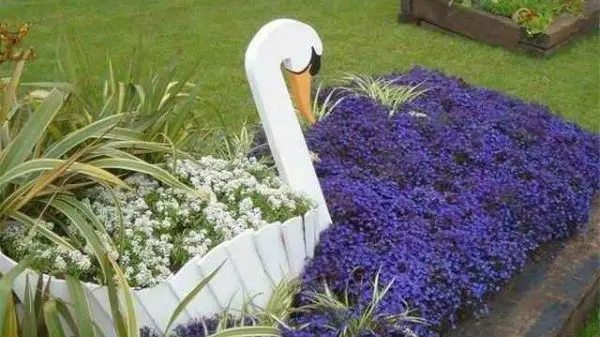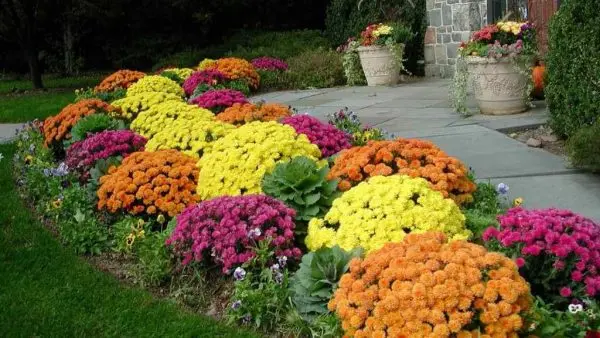Contents
Each owner tries to decorate the area near his house with bright flower beds. And of course, everyone wants these flowering compositions to please with their appearance and aroma throughout the warm season. In this case, do-it-yourself perennial flower beds are the most profitable and rational solution: in such flower beds you do not need to plant or sow plants every year, and the flower bed itself will continuously bloom from spring to late autumn.
The best perennials
To make a beautiful flower bed of perennial flowers with your own hands, you need to carefully approach the choice of plants. It is important not only to take into account the timing of flowering, but also such characteristics as size, height of flowers, soil and light requirements, their combination with other decorative and garden elements. As you know, any flowering composition consists of several types of plants, and the general appearance and splendor of not only the flower garden itself, but the entire landscape depends on how correctly they are selected and located in the flower bed.

The most popular and unpretentious perennials are:
- from undersized species: crocuses, snowdrops, primroses, hyacinths, carnations;
- from biennial species: daisies, forget-me-nots, pansies;
- from flowers of medium height: daylilies, phloxes, irises, peonies, tulips, daisies and bluebells;
- tall flowers: garden lilies, roses, lupins, delphinium, aconite, decorative blooming sunflowers;
- you can fill the space between the flowers with undersized or ground cover species: muscari, thyme, undersized asters, salvia, stonecrop, periwinkle.
When creating flower beds with your own hands in the country, you can use not only garden flowers, but also medicinal plants, which will then replenish your home first aid kit. Echinacea, calendula, sage, lavender are the most luxuriantly flowering and fragrant medicinal species.
Also, do not forget about evergreen ornamental deciduous shrubs and conifers. After all, in winter they will form the basis of the composition. And in the summer, you can dilute the flowers with contrasting greens with the help of ferns.
Video “Tips for gardeners”
Demonstrative video with examples for gardeners on the care and creation of a flower bed.
Flowerbed for beginners
For gardeners who do not have experience in arranging flower beds with their own hands, it may seem that creating a flower bed from perennials is a time-consuming and difficult task. In fact, everyone can make a bright composition of perennial flowers in the country, given the following tips:
- any flowering flower bed begins with drawing up a diagram that accurately indicates the location of the plants – in the future, the diagram will help not to get confused during planting;
- when drawing up the scheme, it must be taken into account that at least 3 species should bloom at one time, and make a selection of plants according to the timing of flowering;
- the scheme should also take into account the selection of plants according to the color palette;
- when creating a flower garden with your own hands for the first time, you should give preference to unpretentious species that do not require complex care;
- the flowering composition looks more spectacular when the plants are planted in small groups, and visually create a bright spot – this is also taken into account when drawing up the scheme;
- you should not overload the composition with a large number of flowers and plant them tightly to each other, because they grow over time – the scheme should take this into account;

- so that flower beds with perennials are always blooming and beautiful, you need to select for planting only those plants that are suitable for this soil.
But the most important thing in creating a flower garden scheme is to correctly calculate the number of plants, taking into account the dimensions of the flowers and the size of the flower bed itself. So from high species (1-2 m) in one composition there should be 2-5 plants, medium-high (50-90 cm) – 5-10 plants, undersized (20-40 cm) – 8-12 pieces, ground cover – 12- 18 pieces, bulbous – 15-25. This scheme allows you to form harmonious flowering compositions.
Flowerbed of continuous flowering
A flower bed that blooms all four seasons is the dream of every cottage owner. And in order to turn it into reality, and make such a flower garden with your own hands, you just need to make the right combination, taking into account the flowering period of each perennial. The main condition for compiling a composition of continuous flowering is the presence of at least one flowering group. To make such a flower garden, you need to know the flowering time of certain plants:
- in early spring (March) snowdrops, crocuses, blueberries, hyacinths bloom;

- in April – lungwort, daisies, primroses, pansies, muscari, early tulips and daffodils;
- May and June are the most flowering months; lilies of the valley, tulips, daffodils, forget-me-nots bloom in May;
- in June, peonies, daisies, bluebells, poppies, daylilies, delphiniums, lupins, petunias and many other flowers bloom;
- in July – late lilies, phloxes, nasturtiums, dahlias, astilbes, roses;
- in August – phloxes, roses, astilbes, some lilies, dahlias, and also rudbeckia, gladiolus, summer chrysanthemums begin to bloom;
- in September – marigolds, asters, dahlias, late chrysanthemums, and tea roses bloom for the second time;
- in October, only the flowering of late dahlias, some varieties of roses and chrysanthemums falls.
So that in winter the flower bed does not seem empty, evergreen coniferous and decorative-deciduous crops should be added to the composition: undersized juniper, boxwood, spherical holly.

Landing patterns
Any flowering composition should begin with the construction of a scheme, since it is the scheme that allows you to avoid mistakes in the process of creating a flower garden at the dacha with your own hands. When developing a scheme, it should be remembered that flowering flower beds are of two types: regular and irregular. For summer cottages, of course, irregular ones (mixborders) are more suitable, where there are no specific rules for planting flowers and it all depends only on imagination. However, flower beds of the correct form in the country are quite common.
The scheme should include absolutely all flowering and decorative elements. To arrange the plants in the flower bed according to the scheme, it is important to know from which side it will be viewed:
- the scheme of a square flower garden, overlooked from all sides, as a rule, provides for several tiers of plants, of which the highest are planted in the center, and lower rows are located from them towards the edge;
- the scheme of a rectangular flower bed should take into account the location of the flower garden on the site: if this is the front part, then it is better to plant the same type of flowers in rows, if the flower garden is located near the fence, the wall, then the scheme is different – the plants are arranged from tall to lower;

- a round flowering flower bed can be planted both in regular rows and in bright spots – examples of the ideal scheme of a round composition: the center is filled with bright large flowers (tulips, roses) along the edge – undersized flowers (daffodils, asters, salvias), and between them muscari or thyme .
Often, when drawing up a scheme, novice gardeners do not take into account the color scheme, but meanwhile, the scheme of a flower bed for a summer residence must take this moment into account. This is very important when creating mixborders with your own hands, where the flowering composition is planted randomly, and if the palette is not followed, it turns out to be too colorful. A flowering composition for giving can also consist of plants of the same species, and drawing up a diagram in this case is not required. A flower garden looks luxurious, filled, for example, with roses or tulips of different varieties and shades.
Flowerbed care
As a rule, perennials are not very whimsical, however, in order for the flowering composition to serve as a decoration for the cottage all season, some effort must be made:
- systematically loosen the soil and remove weeds – it is better to carry out this procedure in the evening or early morning;

- constantly monitor the condition of flowers and eliminate faded inflorescences in time;
- flowering perennials need regular feeding with special mineral mixtures during budding and flowering;
- watering is carried out as needed, while it is important to ensure that water does not fall on flowering sockets;
- if there are open areas in the flower bed, mulching can be done – this procedure will prevent the soil from drying out and the growth of weeds.
In late autumn, all perennials, except for evergreen shrubs, need to be cut, and some heat-loving varieties should be covered for the winter. When performing these simple activities, a fragrant, abundantly flowering flower bed in the country, made by yourself, will delight you for many years.

Video “A selection of beautiful options for flower beds”
Video selection with beautiful options for flower beds for summer cottages.
Author: Svetlana Galitsina
Loading…









